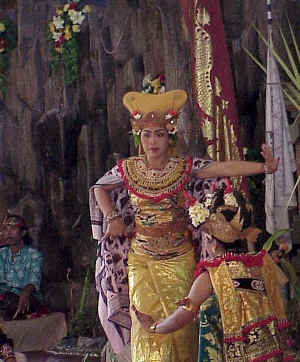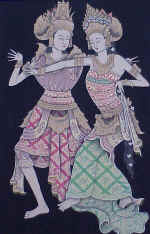Music and Dance and Traditional Entertainment
Arja and Drama Gong
A performance of Arja Balinese Folk Opera can hold an entire village engrossed from late evening until nearly sunrise. Love stories drawn from the classics of the ancient kingdoms of Java are reenacted with all the tragic, comic and romantic ingredients guaranteed to appeal. The royal characters move in a slow stylized dance and sing and talk in a high falsetto using high Balinese, which is translated into common language by the comedians. Arja has lost some of its popularity in recent years in favor of the Drama Gong, which has less music and dance and therefore is much more easily understood by the masses.
Barong and Rangda
The endless metaphysical battle between good and evil is symbolically reenacted time and time again by two weird characters, Barong and Rangda, who by their very performance reinforce the magic power of the village and restore the balance between good and evil. The Barong, representative of the right, white magic and the good forces of nature is a strange long swaybak creature that takes two strong men to animate. His adversary Rangda is Queen of the Witches, an ugly creature with long nails, tongue and fangs. The dual strength of their magic power is enough to drive men crazy as they clash. The Barong’s followers attack the terrible witch with their Kris daggers, only to find their weapons turned black against themselves by an evil spell. However the good is not to be overwhelmed, the Barong’s white magic is strong enough to protect his crazed followers from harm.
Baris
A dance of war, the Baris is strong and masculine, yet also displays strong sensitivity in the myriad of moods and expressions displayed within the dance. The Baris Gede, a sacred dance usually only performed during ceremonies, consist of ten or more elegantly dressed warriors with distinctive triangular white headdresses and bearing weapons, either spears, spiked shields or swords. They dance in line, posing aggressively before each other in simulated battles.
Kecak
Out of the male chorus chant, which produces the trance of the Sanghyang ceremony, has developed a new dance; the Kecak, Usually over 100 men participate. Providing their own orchestration with a counter pattern of vocal sounds that complement their rhythmical movement, creating a living circular stage for the reenactment of an excerpt from the Ramayana story by flickering torchlight.
Legong Keraton
Perhaps the most exquisite of Balinese dances is the classic Legong, a dance traditionally performed as entertainment for the King. Young girls wrapped from head to ankle in hand-painted gold brocades, with glittering gold mirrored head-dresses topped with trembling frangipani flowers, glide with delicate movements which portray the ancient story of King Lasem and his unsuccessful love suite. The dancers seem to be the essence of all that is feminine and beautiful.
Shadow Puppet Show
Known as Wayang Kulit, these shows are an important part of traditional Balinese life. They convey modern ideals and current news and are instrumental in holding on to the past and teaching the young about important aspects of their lives to come. Many of the stories told in the form of Wayang Kulit are from Hindu epics such as the Ramayana. In the shows flat puppets made of stiff leather are manipulated behind a thin white screen that is back lit with an oil lamp. The action of the puppets are accented by voices that correspond with the character and an orchestra of gamelan.

